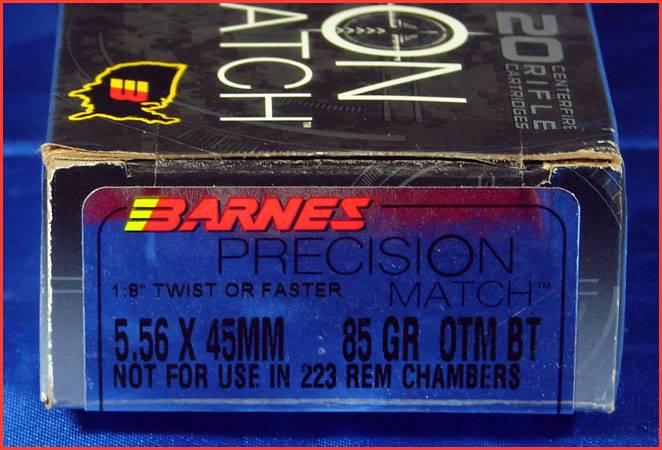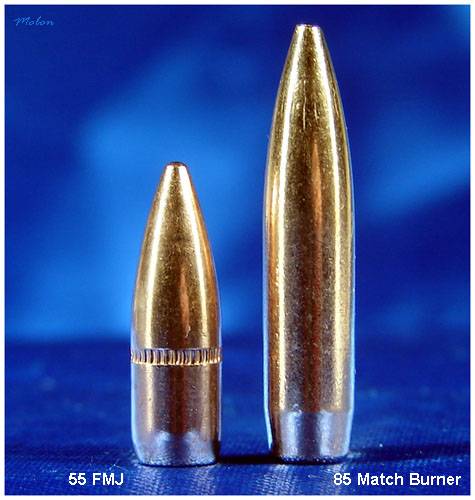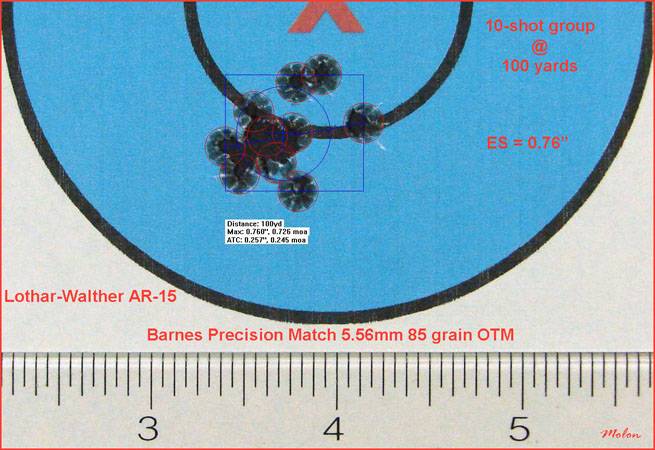Black Hills MK262 Mod1 Ammunition

The 77 grain MK262 ammunition produced by Black Hills Ammunition has been referred to as the most accurate mass-produced 5.56mm ammunition that has ever been type-classified and issued by the US military. Since its inception, genuine MK262 has been manufactured solely by Black Hills Ammunition. For years, MK262 was only available to the civilian population as “seconds,” but more recently Black Hills has made first-run production lots available on the commercial market. It is the first-run version of MK262 Mod 1 that I tested for this report.
MK262 Mod 1 is loaded in WCC 5.56mm brass and uses a cannelured version of the 77 grain Sierra MatchKing. The round is charged with a proprietary ball powder. The primer pockets are crimped and sealed. Contrary to erroneous information that has been posted on the Internet, MK262 Mod 1 does not have case-mouth sealant.

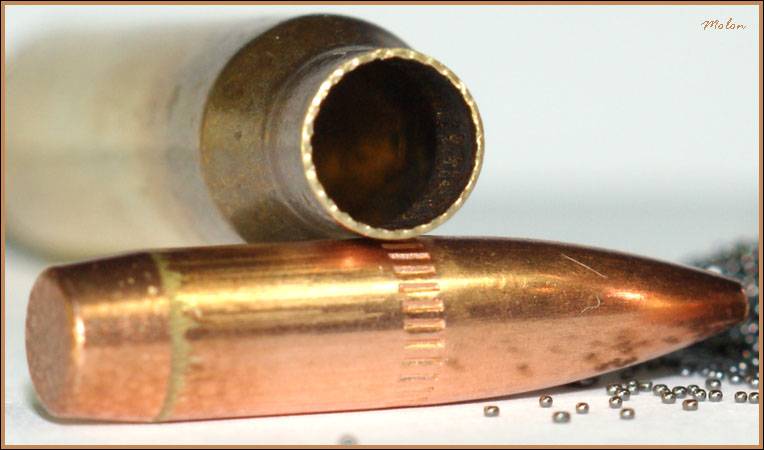
The 77 grain MK262 Mod 1 projectile compared to the M193 projectile.

MK262 powder. (The squares of the red grid measure 1/10 of an inch.)
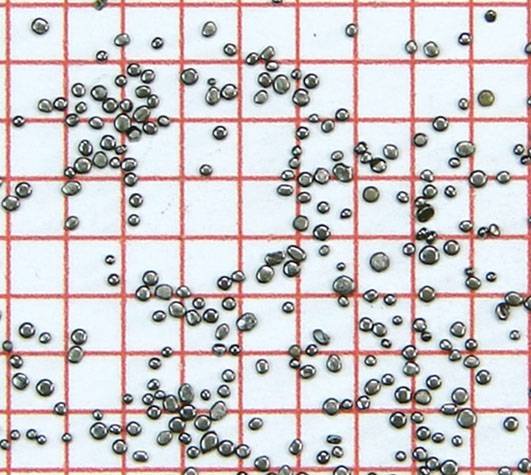
Velocity
I chronographed the Black Hills 5.56mm MK262 Mod 1 ammunition from a semi-automatic AR-15 with a chrome-lined, NATO chambered 20” Colt M16A2 barrel.

Chronographing was conducted using an Oehler 35-P chronograph with “proof screen” technology. The Oehler 35P chronograph is actually two chronographs in one package that takes two separate chronograph readings for each shot and then has its onboard computer analyze the data to determine if there is any statistically significant difference between the two readings. If there is, the chronograph “flags” the shot to let you know that the data is invalid. There was no invalid data flagged during this testing.
The velocity stated below is the muzzle velocity as calculated from the instrumental velocity using Oehler’s Ballistic Explorer software program. The string of fire consisted of 10 rounds over the chronograph.
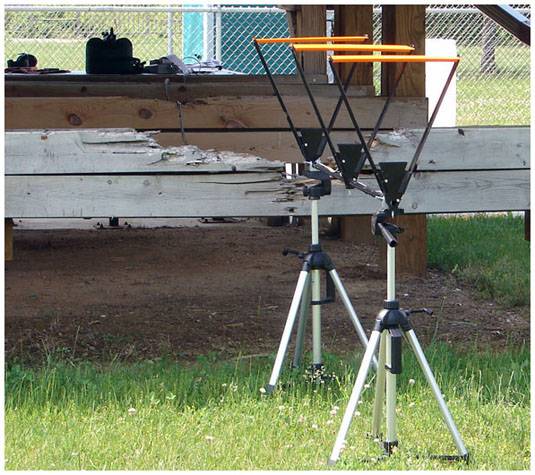

Each round was single-loaded and cycled into the chamber from a magazine fitted with a single-load follower. The bolt locked-back after each shot allowing the chamber to cool in between each shot. This technique was used to mitigate the possible influence of “chamber-soak” on velocity data. Each new shot was fired in a consistent manner after hitting the bolt release. Atmospheric conditions were monitored and recorded using a Kestrel 4000 Pocket Weather Tracker.

Atmospheric conditions
Temperature: 79 degrees F
Humidity: 37%
Barometric pressure: 30.12 inches of Hg
Elevation: 950 feet above sea level
The muzzle velocity for the 10-shot string of the Black Hills 5.56mm MK262 Mod 1 ammunition fired from the 20” Colt barrel was 2848 FPS with a standard deviation of 10 FPS and a coefficient of variation of 0.35%
For those of you who might not be familiar with the coefficient of variation (CV), it is the standard deviation, divided by the mean (average) muzzle velocity and then multiplied by 100 and expressed as a percentage. It allows for the comparison of the uniformity of velocity between loads in different velocity spectrums; e.g. 77 grain loads running around 2,650 fps compared to 55 grain loads running around 3,250 fps.
For comparison (and to give you an idea of how good the CV is for this factory loaded MK262 Mod 1 ammunition) the mil-spec for M193 allows for a coefficient of variation of approximately 1.2%, while one of my best 77 grain OTM hand-loads, with a muzzle velocity of 2639 PFS and a standard deviation of 4 FPS, has a coefficient of variation of 0.15%.

Accuracy
The specification for the accuracy/precision portion of the lot-acceptance-testing of MK262 calls for multiple 10shot groups to be fired from machine-rested, heavy test barrels. I conducted an accuracy (technically, precision) evaluation of the first-run MK262 Mod 1 ammunition following my usual protocol. This accuracy evaluation used statistically significant shot-group sizes and every single shot in a fired group was included in the measurements. There was absolutely no use of any Group Reduction Techniques (e.g. fliers, target movement, Butterfly Shots).
The shooting set-up will be described in detail below. As many of the significant variables as was practicable were controlled for. Also, a control group was fired from the test-rifle used in the evaluation using match-grade, hand-loaded ammunition; in order to demonstrate the capability of the barrel. Pictures of shot-groups are posted for documentation.
All shooting was conducted from a concrete bench-rest from a distance of 100 yards (confirmed with a laser rangefinder.) The barrel used in the evaluation was free-floated. The free-float handguards of the rifle rested in a Sinclair Windage Benchrest, while the stock of the rifle rested in a Protektor bunny-ear rear bag. Sighting was accomplished via a Leupold VARI-X III set at 25X magnification and adjusted to be parallax-free at 100 yards. A mirage shade was attached to the top of the free-float hand-guard. Wind conditions on the shooting range were continuously monitored using a Wind Probe. The set-up was very similar to that pictured below.
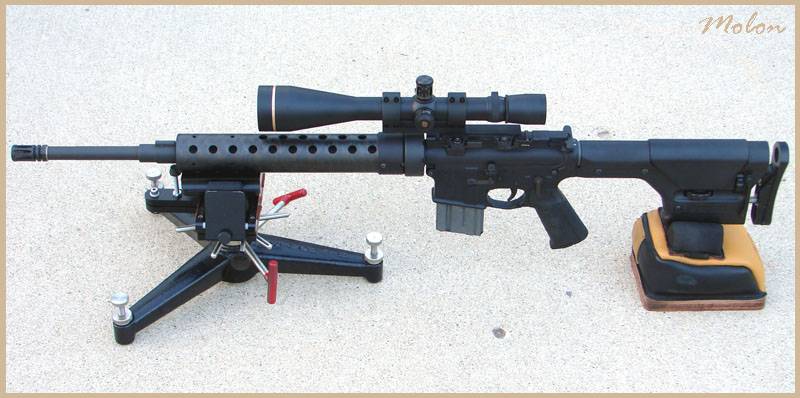
The Wind Probe.
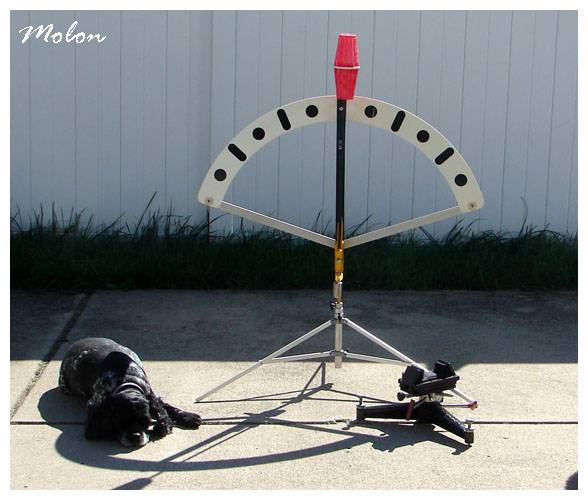
The test vehicle for this evaluation was one of my semi-automatic precision AR-15s with a 20” stainless-steel Lothar Walther barrel. The barrel has a 223 Wylde chamber with a 1:8” twist.
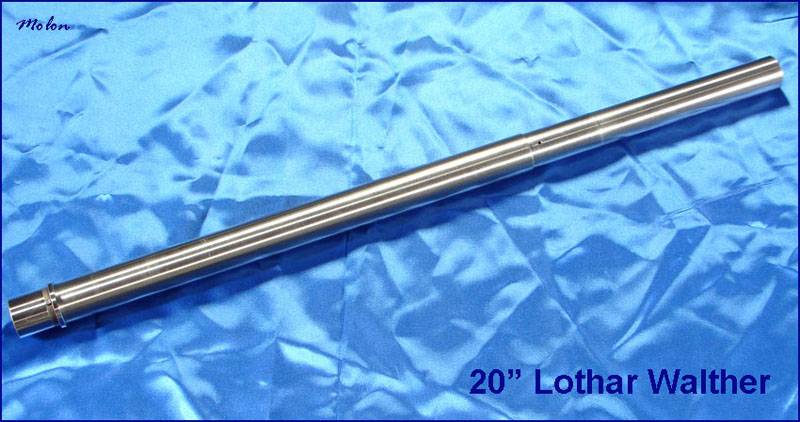
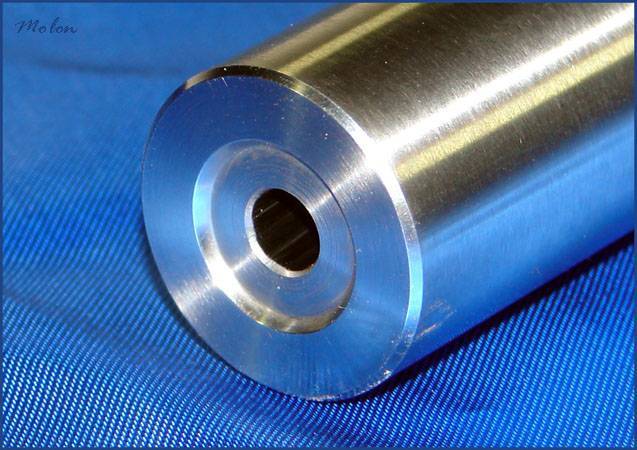
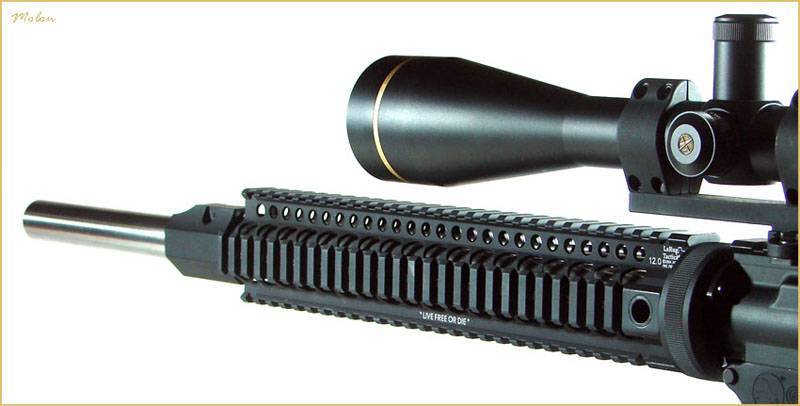
Prior to firing the MK262 ammunition, I fired a 10-shot control group using match-grade hand-loads topped with the Sierra 77 grain MatchKing. That group had an extreme spread of 0.69”.
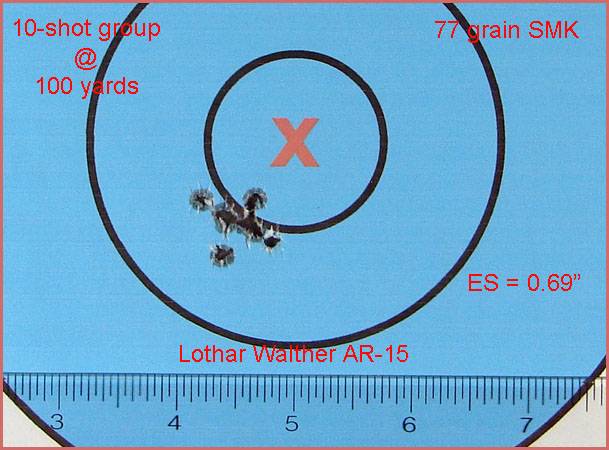
Three 10-shot groups of the MK262 Mod 1 were fired in a row with the resulting extreme spreads (from smallest to largest):
0.96”
1.12”
1.21”
for a 10-shot group average extreme spread of 1.10”. The three 10-shot groups were over-layed on each other using RSI Shooting Lab to form a 30-shot composite group. The mean radius for the 30-shot composite group was 0.33”.
The smallest 10-shot group.
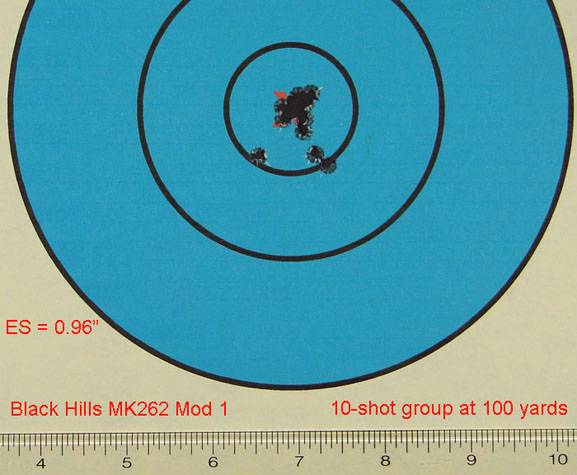
The 30-shot composite group.
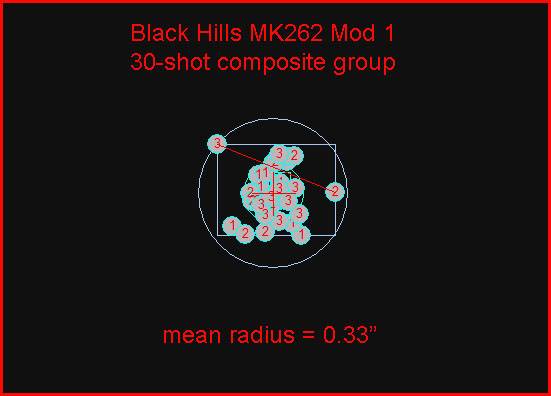

….

The 77 grain MK262 ammunition produced by Black Hills Ammunition has been referred to as the most accurate mass-produced 5.56mm ammunition that has ever been type-classified and issued by the US military. Since its inception, genuine MK262 has been manufactured solely by Black Hills Ammunition. For years, MK262 was only available to the civilian population as “seconds,” but more recently Black Hills has made first-run production lots available on the commercial market. It is the first-run version of MK262 Mod 1 that I tested for this report.
MK262 Mod 1 is loaded in WCC 5.56mm brass and uses a cannelured version of the 77 grain Sierra MatchKing. The round is charged with a proprietary ball powder. The primer pockets are crimped and sealed. Contrary to erroneous information that has been posted on the Internet, MK262 Mod 1 does not have case-mouth sealant.


The 77 grain MK262 Mod 1 projectile compared to the M193 projectile.

MK262 powder. (The squares of the red grid measure 1/10 of an inch.)

Velocity
I chronographed the Black Hills 5.56mm MK262 Mod 1 ammunition from a semi-automatic AR-15 with a chrome-lined, NATO chambered 20” Colt M16A2 barrel.

Chronographing was conducted using an Oehler 35-P chronograph with “proof screen” technology. The Oehler 35P chronograph is actually two chronographs in one package that takes two separate chronograph readings for each shot and then has its onboard computer analyze the data to determine if there is any statistically significant difference between the two readings. If there is, the chronograph “flags” the shot to let you know that the data is invalid. There was no invalid data flagged during this testing.
The velocity stated below is the muzzle velocity as calculated from the instrumental velocity using Oehler’s Ballistic Explorer software program. The string of fire consisted of 10 rounds over the chronograph.


Each round was single-loaded and cycled into the chamber from a magazine fitted with a single-load follower. The bolt locked-back after each shot allowing the chamber to cool in between each shot. This technique was used to mitigate the possible influence of “chamber-soak” on velocity data. Each new shot was fired in a consistent manner after hitting the bolt release. Atmospheric conditions were monitored and recorded using a Kestrel 4000 Pocket Weather Tracker.

Atmospheric conditions
Temperature: 79 degrees F
Humidity: 37%
Barometric pressure: 30.12 inches of Hg
Elevation: 950 feet above sea level
The muzzle velocity for the 10-shot string of the Black Hills 5.56mm MK262 Mod 1 ammunition fired from the 20” Colt barrel was 2848 FPS with a standard deviation of 10 FPS and a coefficient of variation of 0.35%
For those of you who might not be familiar with the coefficient of variation (CV), it is the standard deviation, divided by the mean (average) muzzle velocity and then multiplied by 100 and expressed as a percentage. It allows for the comparison of the uniformity of velocity between loads in different velocity spectrums; e.g. 77 grain loads running around 2,650 fps compared to 55 grain loads running around 3,250 fps.
For comparison (and to give you an idea of how good the CV is for this factory loaded MK262 Mod 1 ammunition) the mil-spec for M193 allows for a coefficient of variation of approximately 1.2%, while one of my best 77 grain OTM hand-loads, with a muzzle velocity of 2639 PFS and a standard deviation of 4 FPS, has a coefficient of variation of 0.15%.

Accuracy
The specification for the accuracy/precision portion of the lot-acceptance-testing of MK262 calls for multiple 10shot groups to be fired from machine-rested, heavy test barrels. I conducted an accuracy (technically, precision) evaluation of the first-run MK262 Mod 1 ammunition following my usual protocol. This accuracy evaluation used statistically significant shot-group sizes and every single shot in a fired group was included in the measurements. There was absolutely no use of any Group Reduction Techniques (e.g. fliers, target movement, Butterfly Shots).
The shooting set-up will be described in detail below. As many of the significant variables as was practicable were controlled for. Also, a control group was fired from the test-rifle used in the evaluation using match-grade, hand-loaded ammunition; in order to demonstrate the capability of the barrel. Pictures of shot-groups are posted for documentation.
All shooting was conducted from a concrete bench-rest from a distance of 100 yards (confirmed with a laser rangefinder.) The barrel used in the evaluation was free-floated. The free-float handguards of the rifle rested in a Sinclair Windage Benchrest, while the stock of the rifle rested in a Protektor bunny-ear rear bag. Sighting was accomplished via a Leupold VARI-X III set at 25X magnification and adjusted to be parallax-free at 100 yards. A mirage shade was attached to the top of the free-float hand-guard. Wind conditions on the shooting range were continuously monitored using a Wind Probe. The set-up was very similar to that pictured below.

The Wind Probe.

The test vehicle for this evaluation was one of my semi-automatic precision AR-15s with a 20” stainless-steel Lothar Walther barrel. The barrel has a 223 Wylde chamber with a 1:8” twist.



Prior to firing the MK262 ammunition, I fired a 10-shot control group using match-grade hand-loads topped with the Sierra 77 grain MatchKing. That group had an extreme spread of 0.69”.

Three 10-shot groups of the MK262 Mod 1 were fired in a row with the resulting extreme spreads (from smallest to largest):
0.96”
1.12”
1.21”
for a 10-shot group average extreme spread of 1.10”. The three 10-shot groups were over-layed on each other using RSI Shooting Lab to form a 30-shot composite group. The mean radius for the 30-shot composite group was 0.33”.
The smallest 10-shot group.

The 30-shot composite group.


….
Last edited:


